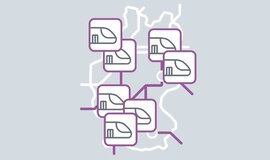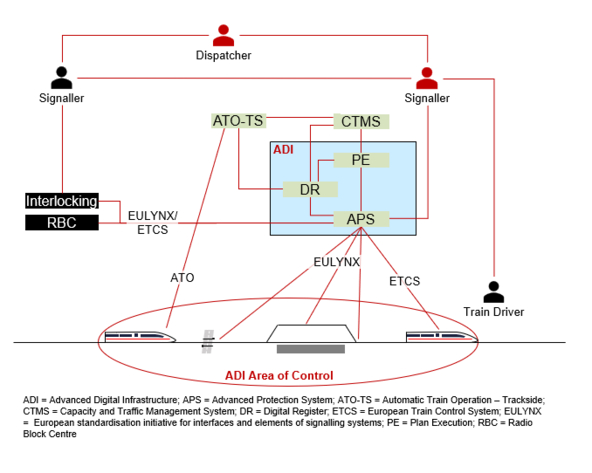
Digitale Schiene Deutschland is working intensively on the development of an "Advanced Digital Infrastructure"
One of the largest potentials for increasing capacity and quality in the rail system –
Integrated control, command and signaling technology (CCS) with train-oriented signaling logic is expected to have a significant impact on the capacity of the existing rail network. As the successor to the previous CCS, the "Advanced Digital Infrastructure (ADI)" will enable trains to run at the shortest possible distances from each other in future (so-called moving block). This means that more trains can travel on the same network. ADI also brings further operational advantages.
The following video explains the technology, benefits and resulting advantages of the “Advanced Digital Infrastructure” concept.
The number of trains on the rail network is generally limited, as they have to travel with large safety distances due to their long braking distances. Today, the tracks are divided into fixed block sections. A section is closed to the following train as long as the preceding train is still in it. The sections are generally designed for long train units and are therefore often longer than necessary for shorter trains.
Optimising these distances is an important goal of the new safety logic. The centrepiece of this is the "Advanced Protection System (APS)". While today's CCS secures according to the occupancy of fixed blocks, APS is train-oriented: The train is now viewed as an object with its actual extension in the network, including safety surcharges. Fixed blocks lose their function and trains can run in so-called moving blocks at the smallest possible distances from each other - according to their length, their braking distance and the current operating situation. The result: a denser train sequence and therefore more trains travelling on the existing network - without the construction of new infrastructure.
However, the added value of APS is only realised in combination with other Digitale Schiene Deutschland technologies. This is why the various functions are bundled in the overall Advanced Digital Infrastructure (ADI) concept (see illustration).
In addition to APS, ADI also includes the Digital Register (DR) as a central source of infrastructure data and Plan Execution (PE) as an intelligent control system and bridge to the capacity and traffic management system (CTMS). ADI uses various European standardised interfaces (so-called EULYNX specifications) to peripheral systems such as points and also enables the use of Automatic Train Operation (ATO). This makes ADI a completely European security system and a revolutionary development step in CCS.
In addition to running in "moving blocks", ADI offers a number of other operational advantages:
- Combination of interlocking and ETCS radio block centre in one system: This reduces complexity and overcomes the historically grown, different modes of operation.
- Generic safety: By providing all infrastructure data in the digital register (e.g. points) as standardised data objects, the project planning of the specific infrastructure, i.e. the planning of the objects on site, can be significantly simplified.
- Geometric safety: By synchronising the position and excluding possible overlaps of all recorded objects (usually trains), all possible connections in the track network can be used flexibly and safely from A to B.
- Reduction of outdoor facilities: Many track vacancy detection sections can be dispensed with. The installation and maintenance of corresponding outdoor systems is no longer necessary, which saves costs and reduces maintenance work.
This technical development is also accompanied by a change in operational processes. In order to arrive at a technical specification, the definition of operational use cases - the operating scenarios - is an essential basis. In a current technical article published in Eisenbahntechnische Rundschau magazine (07+08/24), the ADI concept is presented in its entirety and the procedure for creating operating scenarios is described in detail.
